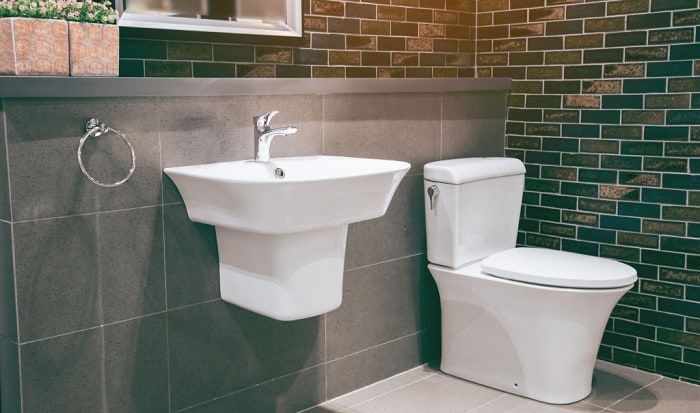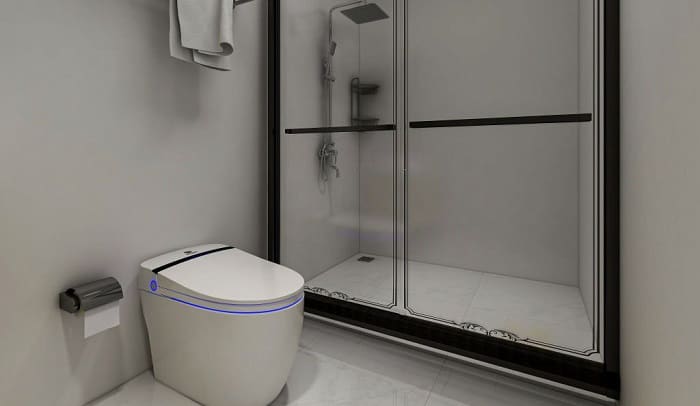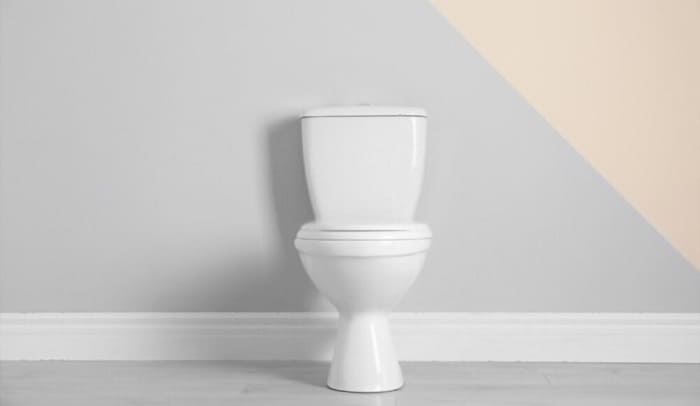Toilets always have a clean, refined appearance. You might wonder ‘what are toilets made of?’ to maintain their customarily spotless and elegant appearance. Continue reading to find answers to your questions!
The majority of toilets are built of porcelain or ceramic, although certain cutting-edge models are also available in steel, plastic, and wood to accommodate usage in a variety of settings.
Table of Contents
Toilet Materials List
1. Porcelain/Ceramic
The most common material for making toilets nowadays, porcelain is a ceramic-based material favored for its non-porous nature and resilience. Once molded into the desired shape, the thick slurry of clay is then exposed to extreme temperatures (nearly 2400°F).
The temperature range used for firing clay is the main difference that sets porcelain and ceramic apart, despite their nearly identical materials. Where porcelain is fired within a range of roughly 2200-2400°F, ceramic is only exposed to 1500-2000°F.
Ceramic toilets or toilets made of porcelain with Vitreous China glaze offer crucial aspects of a toilet. These include support for the flushing mechanism, waterproofness, cleanliness, and sleek aesthetics, making it the ideal material for manufacturing toilets.
2. Metals
Metals, especially steel, are the preferred materials for toilets in jails, railway vehicles, and airplanes due to their exceptional durability. These materials are best at lowering possible risks in caution-worthy places, like prison breaks in prison establishments.
Similar to porcelain, metal is a non-porous material that makes maintenance and cleaning a walk in the park. As long as you clean the toilet regularly, you’ll find it impossible for unwanted odor from wastes to linger.
However, metal toilets, such as stainless steel toilets, do not provide the optimum level of comfort to their users. Metals adapt to the temperature of their surroundings: hot in summer and cold in winter.
3. Plastic
Another non porcelain toilet made available in the market is plastic toilets. Plastic is frequently used to create portable toilets for simple and practical usage. Particularly, polypropylene is the most common type of toilet plastic utilized.
Notwithstanding, these toilets are uncommon because they are expensive to produce. Frequent contact with water can also lead to sanitary problems, regardless of how regularly you clean the toilet.
4. Wood
Another material that can be utilized to build a toilet is wood; however, it’s not a common choice these days. You can build your own eco-friendly toilet at home or on your farms using only a pail, straws, and wood.
Unlike conventional toilets, wood toilets are frequently used to generate a dry toilet or composting toilet. This means the waste is sent to a treatment facility for organic use rather than being flushed via the drainage system.
Types of Toilet
There are many distinct kinds of toilets readily available on the market, but the ones listed below are the most popular among homeowners and establishments.
1. Dual-Flush Toilets
A popular choice recommended by many users on Reddit, this toilet type features a dual flush valve that lets you either go for a full flush (6 liters) or a half flush (3 liters). Thanks to this innovative system, you can drastically cut down on water consumption.
Read more: Dual flush vs single flush toilet: what is the difference?
2. Double Cyclone Flush
Double cyclone flush uses less water for flushing yet has a similar amount of flushing power as a full flush, thus reducing your water usage, consequently your water bill.
3. Pressure Assisted Toilets
Due to its system, which uses air pressure to push water into the toilet tank, this type of toilet offers an effective flush.
4. Gravity-Flush Toilet
Toilets that flush with gravity are quiet and require very little upkeep over time due to their simplistic designs. Additionally, they can ensure that you practically never have to bother about having a clogged toilet.
Read more: Gravity vs pressure assist toilets: what is the difference?
5. Composting Toilets
This style of toilet uses human excrement to create other beneficial compounds that can be used in a variety of ways. Composting results in a product that works well on plants, lowering the demand for synthetic fertilizers and conserving the quality of nearby water.
6. Waterless “Dry Sanitation” Toilet
They are ideal for places with poor infrastructure, sustainability considerations, or water shortage challenges as they don’t depend on water to flush a toilet.
7. Upflush Toilet
Upflush toilets do not require complicated sewer systems or openings to be drilled into the floor of the bathroom. They may fit anywhere in your home and are completely moveable.
8. Portable Toilets
As indicated in the names, these are toilets that are designed to be easily moved around. Instead of a plumbing system, they feature a holding tank with germicide chemicals. Portable toilets are a common choice for outdoor events.
Most Reliable Toilets Manufacturers in USA
Toilets made in USA come from various manufacturers. The most common toilet producers that you can definitely count on are:
- American Standard
- Delta Faucet
- Duravit
- Kohler
- Mansfield Plumbing
- Niagara Corp.
- PROFLO
- Saniflo
- Sloan Valve Company
- Toto
- Zurn Industries
These businesses may be relied upon to provide high-quality, cutting-edge toilets of various types. They also offer different toilet material types that suit your budget and choice of comfort.
Frequently Asked Questions
What type of material is most toilets made of?
Most contemporary toilets are made of porcelain, a tough ceramic material. However, a small percentage of toilets, like those in jails and prisons, also use steel. While others make use of wood and plastic.
Why are toilets still made of porcelain?
Toilets need to be made from materials that are watertight, easy to clean, sanitary, durable, not sensitive to temperature variations, and aesthetically pleasing. Porcelain, or vitreous china clay, fits all these criteria.
Additionally, producing toilets from vitreous china clay is a rather straightforward operation. The clay is removed, poured into molds, completed, and then fired in a kiln. It’s a rather simple technique that is also reasonably priced.
How do I know if my toilet is ceramic or porcelain?
The easiest way to distinguish between ceramic or porcelain is to run your hand through the material. A smoother finish means that the toilet is made from porcelain, whereas a rougher surface equals ceramic.
You can also examine the chipped glazing. A uniform color indicates that the toilet is indeed porcelain, as opposed to the white or tan foundation commonly seen in ceramic.
Conclusion
Most toilets have a uniformly white aesthetic. However, this is not always the case because the materials, types, and designs employed might vary depending on certain conditions and situations.
Regardless of the materials and configurations used, they all strive to provide you with their innovative features to make your bathroom routines comfortable.
Now that you know the answer to “what are toilets made of”, I hope you can make an informed decision when buying this bathroom must-have. Let me know if you’re happy with your purchase.

I’m Paulk Webb, and I work as a writer for Saveourwaterrebates. I’m happy to put in the time and effort to conduct market research to identify the most pressing issues faced by households concerning their plumbing. Feel free to check out our guides to get the most informed recommendations for how to solve your problems.





